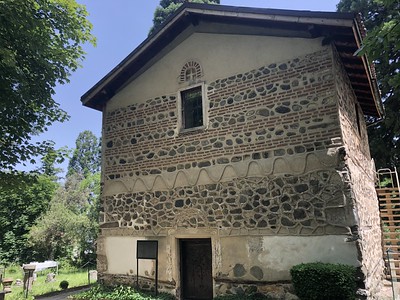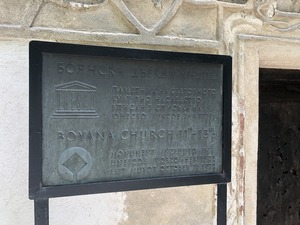Boyana Church

Boyana Church is a remarkable medieval monument with especially fine wall paintings.
The architecture of the original Boyana Church dates from the late 10th and early 11th centuries, while the current building also sees additions from the mid-13th century and mid-19th century. The paintings date from 1259. In all, there are 240 depictions on the walls. Its painter is still anonymous but stands for the team that decorated the church and that was trained in the studios of the Turnove Art School.
Community Perspective: the church is easily accessible as it lies on the outskirts of Sofia, though it takes a bit of a walk when using public transport. They only let in small groups at a time with a minder/guide, but a visit doesn’t take more than a few minutes.

Map of Boyana Church
Load mapCommunity Reviews
Clyde

I visited this WHS in 2023 just before entering Sofia. Parking is free at the park nearby and it can get quite busy in the summer months, so calling in advance and booking a spot is recommended if you want to be on the safe side. Every last Monday of the month after 15:00 there's free admission too. Small groups of around 10-15 people are allowed inside and "locked" in for around 20 minutes to view the frescoes inside.
While waiting for your time slot, there isn't much to do. The church exterior's best view is towards its nave and southern facade. The rest is either covered by the tall trees surrounding it or by the ugly metal staircase leading to the tiny cupola. Next to the entrance on the western facade is the UNESCO WHS inscription plaque. On the opposite side are a few simple gravestones (one of them of Eleonara Queen of Bulgaria) and a remarkable tall redwood tree. Make sure to visit during opening hours as you won't see much of the exterior otherwise either.
Located on the outskirts of Sofia in the southern foothills of the Vitosha mountain, the Boyana Church actually consists of three buildings. The eastern church was built in the 10th century, then it was enlarged at the beginning of the 13th century by Sebastocrator Kaloyan, who ordered a second two storey building to be erected just next to it. The frescoes in this second church, painted in 1259, make it one of the most important collections of medieval paintings. The ensemble is completed by a third church built at the beginning of the 19th century. As such, the small Christian church's true highlight are its three layers of frescoes, painted in the 11th, 13th and 16th centuries respectively. The first fresco layers used to cover the entire eastern section of the church. Fragments of this layer can be seen in the lower parts of the apse and the northern wall, the upper sides of the western wall, and the western and southern vaults. According to the inscription of 1259, this first layer of frescoes has been covered with a new coat of plaster and another layer of frescoes has been painted over it. In the western facade there's also a charcoal graffito which dates back to 1259.
Notwithstanding its very small size overall, the church houses over 240 frescoes in total. The apse of the first section of the church is dominated by the grand image of Christ Pantocrator. Underneath, the drum exhibits paintings of angels and the four evangelists, while the vault contains four images of Christ, followed by scenes of the major feast days and the passion of Christ. On the northern wall of the nave there is a fresco of the Last Supper as well as St. Elena and unknown soldier saints. Above the altar, there is a fresco of the Holy Virgin and Child Enthroned. Apart from images of Christ, perhaps the second most recurring images are those of St. Nicholas, one of the patron saints of the temple. Probably the most vivid of them all is the fresco of the Miracle at Sea, with the ship and sailor hats as reminders of the Venetian fleet. My favourite frescoes are those of the full-length portraits of the ktitors Sebastokrator Kaloyan and his wife Desislava, as well as the Bulgarian tsar Constantine Asen Tikh and the tsaritsca Irina. Kaloyan holds a model of the Boyana Church in his hands, which he donates to St. Nicholas. These four portraits, painted with precise details, are the oldest surviving portrayals of historical figures.
For once, joining a restless group including children helped to "distract" the church caretaker who was solely concerned that nobody touches the frescoes, so in the meantime I took a couple of photos and videos to be able to remember the great interior in the future. All in all, the Boyana Church was the highlight of Sofia, and visiting on a separate day before visiting the Rila Monastery helped to differentiate between both painted interiors.
CugelVance

I visited the boyana church twice,on the 16th and 17th of january.
Why?? Because I like that church that much? No,not all. Personally,I was not very impressed with the boyana church. Sure, the frescoes are impressive......and they are the only reason to visit this church. The church itself is nothing special at all. Due to wrong information on the website of the tour agency(according to them the boyana church was closed the 17th of jan) which offers trips from Sofia to the rila monastery I thought that I wouldnt be able to visit the church on my trip to the monastery. I arrived in Sofia in the afternoon on jan the 16th,checked in my accomodation,rushed out to take the metro and a long bus trip( to metro station"Vitosha" next to the shopping centre"paradise center" and from there with bus nr64) out to the suburb where the boyana church is locacated and managed to enter the church shortly before closing time. Suprise,suprise,next day that agency 's minibus first made its way to the boyana church before heading to the rila monastery.
On the 16th shortly before closing time I had the church to myself .Beautiful frescoes,but I have seen more beautiful ones in other orthodox churches in eastern europe and russia.
I understand the reasons why the boyana church is a unesco site,and rightfully so,but it is not my cup of teak,so to speak.
Els Slots

Boyana Church can be found in a residential neighbourhood on the outskirts of Sofia. On my first visit, my taxi driver didn't know its location, but after asking for some directions we safely arrived there. The little church is hidden in a lovely park. I had to wait there sometime before I was able to buy a ticket, and later before I was allowed to get into the church (because of its small size, only small groups can go in at the same time). The inside of the church is the reason to go here. All its walls are covered with frescoes. Dark blue is the main colour, and the paintings are now in good repair.
During my second visit, I arrived in a rental car. There is little parking in the street in front of it, but as visitors never will stay long that won't be a problem. Tickets are sold in a special booth near the entrance - the fee is 10 Lev (5 EUR). From there you walk a few hundred meters through a forest until you come to a sign where you are supposed to wait your turn to enter the church. There were no other visitors however when I visited on a Friday afternoon in late June. A woman let me in and I had to leave my small backpack in the front room, before entering the church halls with the paintings.
What struck me most this time is how small it all is. The paintings are surely worth it, they are very clear and in good shape. Especially when you consider that they were made in the 13th century. Since my previous visit, and also that of other reviewers (the last in 2017), a WHS plaque has been added. It is attached to the left of the church door, at the white plaster that you can see in all pictures of the church front.
History Fangirl

Boyana Church is in a quiet, upscale neighborhood on the outskirts of Sofia. It has three distinct eras of construction, from the 10th, 13th, and 19th centuries. The church was restored and maintained with the support of Queen Eleonora, whose grave is on the site.
Inside, there are original frescoes, including one I particularily liked of St. Sofia.
Visiting is easy, it's a quick (maybe 10-15 leva) taxi ride from almost anywhere in the city. In Boyana neighborhood is a movie studio, so if you want to try your luck at spotting American actors on a lunch break, head to the restaurant Cinnecitta nearby afterward.
I have a full write-up here: UNESCO World Heritage Site: Boyana Church.
Nan

On my last day in Sofia, I went to Boyana Church. It’s a small church with very nice frescos on the outskirts of Sofia facing the mountains. The original church built in the 10th century was extended repeatedly. Repeatedly new layers of frescos were added atop of the previous frescos. The key frescos of the church are from the 12th century. Interestingly, you can see the different layers at some spots in the church due to missing parts.
The visit itself is rather quick. It’s a tiny site and I would be surprised if you spend more than 30min here.
Getting There
On my way up I took a tram (#4 or #5, same line you need to go to the bus stop for Rila). From the closest station I simply walked to the church (30min or so). On my way back I took bus #64, but I don’t think it takes you fully into town.
While You Are There
Sofia isn’t a beauty, not even a sleeping one. It’s a bit surprising considering the long history of the city. I did appreciate the Roman ruins and the Sweta Sophia, an early Christian church (4th-5th century).
Boyana Church itself is a good starting point for hiking into the mountains. You can follow the Boyana Cascades up, but it’s quite a climb and partially a very rough trail.
Chris
Visited the Church on 30th May 2014. It's a 20 minute drive to get there from our hotel. We arrived early morning around 10 AM, got the tickets, and had to wait like a minute for like 3 people to get out the church. We are with two people and other 4 joined to go inside. We stayed probably quite long inside as it was very quiet. The church itself, outside, it's a soso. BUT the fresco's......best ones I have seen till today ! Seems I cannot add any photo's here so check my gallery on my blog.
Read more from Chris here.
Joseph Colletti
The church, as of August 2013, is fully restored and the scaffolding is down. The inside is covered with 13th century frescoes, including a cycle of the life of St. Nicholas (later morphed into Santa Claus) as well as portraits of the ruling tsars and tsarinas of the times.
Very well informed guides took groups of five to ten people at a time into the climate controlled church. The interior is small, basically a narrow apse and the nave, with an outer area that has an exhibit about the restoration work.
The frescoes were some of the most beautiful and best preserved (and restored) I saw in Bulgaria. They approach in beauty and artistic sophistication those found in Italy of that period. Rebecca West wondered,(though she was talking about Yugoslavia but still relevant)how far could this painting have advanced but for the Turkish occupation. Compare these to the Russian Revival style paintings from the 18th century in Alexander Nevski and post-Ottoman churches (inferior, almost cartoonish in my non-expert opinion) to get an idea of the various forces that have shaped this part of the world. Boyana restored is certainly worth a visit.
While you wait your turn to enter (the day I was there I only had to wait five minutes or so for the group before me to come out) you should walk around the grounds. The guide, who was also waiting for her turn to enter, spoke about the history of the church, answered questions about the exterior and talked about some of the graves (and their inhabitants)in the nearby cemetery. There are food stands and cafes in the car park just outside the church.
It was about a fifteen minute and $10 or so cab ride from the west (Ovcha Kupel) bus station in Sofia but there are several delightful trolley cars you can take from downtown Sofia to the last stop, Hladinika, then a two minutes walk through a park past some food stands to Bus 64 (it's the beginning of the route)to the Boyana Church stop, about 20 minutes. It costs about one dollar. (I took the bus and trolley back.)
IOM
Visited in June and the church was still closed for conservation apparently.
Be careful in getting taxis from the train station. I thought I got a bargain on the way there, only to be charged half the price on the way back (different taxi)!
Community Rating
- : Thomas Harold Watson CHJLondon Fotoula Don Irwin UncleSlavi StaziG Klara Woodson Roccobot Rafał Kałczuga
- : Mihai Dascalu Hurrvinek
- : George Gdanski DAB Can SARICA RobRos Federico P. Aspasia Kevin McFarland WalGra Christravelblog John Smaranda
- : Rickard Alfredsson Tony H. Tingmelvin Rodinia Stanislaw Warwas Jon Eshuijs David Berlanda GerhardM
- : Juropa Wojciech Fedoruk Philipp Peterer Craig Harder Alex Marcean Christoph Peter Lööv Lichia Svein Elias João Aender Lisu Marian JoStof Riccardo Quaranta Sncjob Priyaranjan Mohapatra Lucio Gorla Czesioszpachelka Daniel C-Hazard Alexander Barabanov Timonator Caminographer Purrfect Ivan Rucek
- : Richard Stone Clyde Aljaz Randi Thomsen Hanming Gary Arndt Jean Lecaillon Tarquinio_Superbo Shandos Cleaver Ari Kailash Philipp Leu Els Slots Roman Raab Mikko Hubert Chenboada Martina Rúčková Dirk-pieter Zoë Sheng Nan Yevhen Ivanovych J_neveryes Daniel Gabi
- : Argo Dorejd Solivagant Shijie ZHU Adrian Turtschi
- : Sachin CugelVance Stanimir Csaba Nováczky Mo-han Je Igloo
- : Erik Jelinek
Site Info
Site History
1979 Inscribed
Site Links
Unesco Website
Official Website
Related
In the News
Connections
The site has 8 connections
Art and Architecture
Geography
History
Timeline
Visiting conditions
WHS Hotspots
World Heritage Process
Visitors
290 Community Members have visited.
The Plaque
 (photo by Els)
(photo by Els)